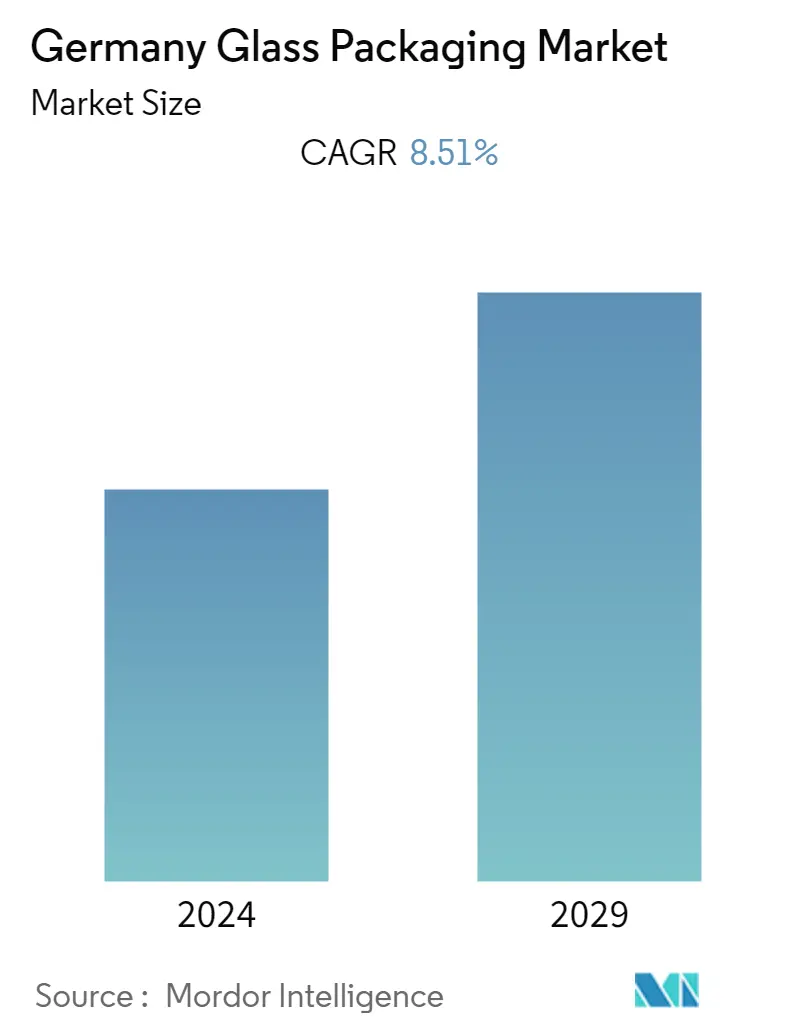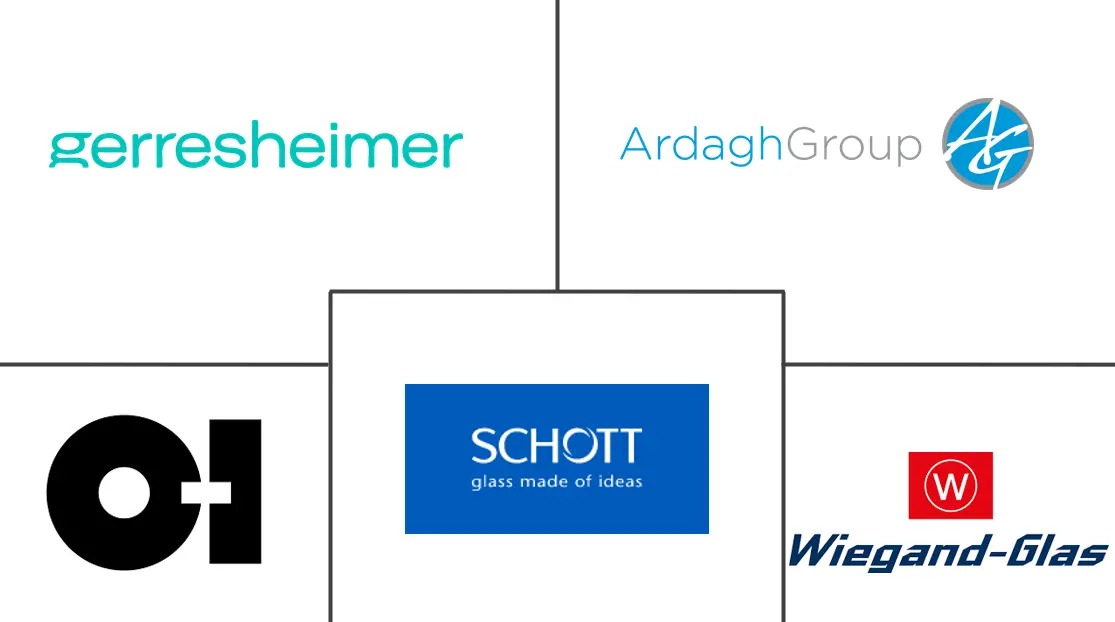Market Size of Germany Glass Packaging Industry

| Study Period | 2019 - 2029 |
| Base Year For Estimation | 2023 |
| Forecast Data Period | 2024 - 2029 |
| Historical Data Period | 2019 - 2022 |
| CAGR | 8.51 % |
| Market Concentration | Medium |
Major Players
*Disclaimer: Major Players sorted in no particular order |
Germany Glass Packaging Market Analysis
The German Glass Packaging Market is expected to register a CAGR of 8.51% during the forecast period. Glass packaging for food is anticipated to expand due to strong demand from industries including soups and baby food. The beer, cider, and spirits industries are also anticipated to contribute to the glass expansion substantially. Additionally, the personal hygiene industry is expected to contribute the most to the growth of this packaging material. Glass packaging for cosmetics and toiletries is expected to increase due to the skincare industry's high demand. There has been impacting of the Russia-Ukraine war on the overall packaging ecosystem.
- Glass manufacturers have been critical players in Germany's reuse and recycling system. Gerresheimer, for instance, began producing glass with a higher proportion of recycled glass at the Tettau site in Germany. By using recycled glass, it aims to create new high-quality cosmetics packaging. Many prominent players, like Gerresheimer, drive circularity and resource savings daily.
- The introduction of stringent laws in the country to enhance the quality and integrity of domestically manufactured drugs is driving an increase in the use of glass for pharmaceutical packaging products. Also, there is a demand for sterile medical packaging products from the pharmaceutical industries, which is anticipated to drive the market's growth during the forecast period. Also, the growing number of drugs packaged in the glass medium is driving the demand for glass-based vials and ampoules.
- Moreover, all stores in Germany that sell beverages must take them back and return the deposit to the customer - whether or not that person bought that beverage from them. The warranty for plastic bottles is EUR 0.25 (USD 0.256), recognizing the higher environmental impact. The deposit for glass bottles is far lower - between EUR 0.08 (USD 0.082) and EUR 0.15 (USD 0.154) - because they can be reused, which will allow customers to give more of a reward for returning plastic and encourage them to buy products in glass bottles because it's cheaper upfront.
- According to The Federal Association of the German Glass Industry, ten big glass producers in Germany generate around 20% of the whole glass industry revenue. Few big international glassmakers are dominating the market presently and are interested in producing glass bottles.
- Further, Coca-Cola, Germany, shifted from PET bottles back to glass bottles; therefore, it needs enormous amounts of glass bottles. The company has invested EUR 50 million (USD 51.29 million) in two new glass production lines in Mannheim and Luneburg. This pressure from the soft drinks industry further affects the supply of glass bottles in the liquor segment.
- The country's expanding disposable income and incorporation into premium packaging are the main drivers of the glass packaging industry. Additionally, the government adopted increased glass packaging due to the mandated trash sorting laws and an incredibly effective deposit refund program that has considerably improved garbage management and raised recycling rates.
- However, shifts in the cost of raw materials and the fierce competition from other packaging materials may reduce the market's development pace. The pandemic's effects on the supply chain, the sensitivity of glass materials, and a rise in operational expenses will further hinder the market growth.
- With the outbreak of COVID-19, the country witnessed significant demand for pharmaceutical glass packaging from the government, which has increased the need for vaccines, especially for vials, bottles, and ampoules, surging since research began to find a vaccine against COVID-19.
Germany Glass Packaging Industry Segmentation
The study for the market tracks the revenue incurred from the sales of the production of glass packaging products in Germany. The analysis is based on the market insights captured through secondary research and through the primaries. The market also covers the major factors impacting the growth of the glass packaging market in terms of drivers and restraints.
The scope of the study covers key industries, such as pharmaceuticals, personal care, household care, and agriculture, among others. The study also covers types such as bottles/containers, vials, ampoules, and jars. The study further covers the assessment of COVID-19 on the German Glass Industry.
The German glass packaging market is segmented by products (Bottles/Containers, Jars, Vials, Ampoules), and end-user industry (Pharmaceuticals, Personal Care, Household Care, and Agricultural). The market sizes and forecasts are provided in terms of value (USD million) for all the above segments.
| By Type | |
| Bottles/Containers | |
| Vials | |
| Ampoules | |
| Jars |
| By End-user Vertical | |
| Pharmaceuticals | |
| Personal Care | |
| Household Care | |
| Agricultural | |
| Other End-user Vertical |
Germany Glass Packaging Market Size Summary
The German glass packaging market is poised for significant growth, driven by robust demand across various sectors such as food, beverages, personal hygiene, and pharmaceuticals. The market is experiencing a shift towards sustainable practices, with companies like Gerresheimer leading the charge by incorporating recycled glass into their production processes. The beer, cider, and spirits industries are expected to contribute substantially to the market's expansion, alongside the personal hygiene sector, which is seeing increased demand for glass packaging in cosmetics and toiletries. The government's stringent regulations on pharmaceutical packaging are further propelling the use of glass, as the demand for sterile medical packaging rises. Additionally, the effective deposit refund program and mandated trash sorting laws are enhancing recycling rates, supporting the market's growth trajectory.
The competitive landscape of the German glass packaging market is characterized by the presence of major players such as Gerresheimer AG, Ardagh Group S.A., and Schott AG, who are actively investing in new technologies and production capacities to meet the rising demand. The market is also witnessing a trend towards innovative and premium packaging solutions, particularly in the beauty and fragrance sectors, where disruptive designs are gaining popularity. The COVID-19 pandemic has further accelerated the demand for pharmaceutical glass packaging, with significant investments in production facilities to meet the needs for vaccine vials and ampoules. Despite challenges such as raw material cost fluctuations and competition from alternative packaging materials, the market is expected to continue its upward momentum, supported by strategic partnerships and technological advancements.
Germany Glass Packaging Market Size - Table of Contents
-
1. MARKET INSIGHTS
-
1.1 Market Overview
-
1.2 Industry Value Chain Analysis
-
1.3 Industry Attractiveness - Porter's Five Forces Analysis
-
1.3.1 Bargaining Power of Suppliers
-
1.3.2 Bargaining Power of Consumers
-
1.3.3 Threat of New Entrants
-
1.3.4 Threat of Substitutes
-
1.3.5 Intensity of Competitive Rivalry
-
-
1.4 Assessment of Impact of COVID-19 on the Germany Glass Industry
-
-
2. MARKET SEGMENTATION
-
2.1 By Type
-
2.1.1 Bottles/Containers
-
2.1.2 Vials
-
2.1.3 Ampoules
-
2.1.4 Jars
-
-
2.2 By End-user Vertical
-
2.2.1 Pharmaceuticals
-
2.2.2 Personal Care
-
2.2.3 Household Care
-
2.2.4 Agricultural
-
2.2.5 Other End-user Vertical
-
-
Germany Glass Packaging Market Size FAQs
What is the current Germany Glass Packaging Market size?
The Germany Glass Packaging Market is projected to register a CAGR of 8.51% during the forecast period (2024-2029)
Who are the key players in Germany Glass Packaging Market?
Gerresheimer AG, Ardagh Group S.A., O-I Glass, Inc., Schott AG and Wiegand-Glas Holding GmbH are the major companies operating in the Germany Glass Packaging Market.

